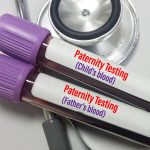It might be beneficial to both pregnant parents to know who the true father of the unborn child is. Pregnancy-related paternity tests can ease anxieties and facilitate parent-child bonding. However, many people are curious about the alternatives and how early can you do a DNA test or prenatal DNA tests on an unborn baby. This article will discuss where to obtain prenatal paternity testing, the precision of tests, and the earliest possible time to establish paternity before delivery. For a thorough overview of DNA testing while pregnant, continue reading. Whether you want to determine paternity as promptly as possible or have inquiries regarding the procedure and timeline is relevant.
Can you do a DNA test while pregnant?
It is possible to do paternity tests while pregnant to ascertain whether a guy is the unborn child’s genetic father. The most reliable methods for determining paternity prior to childbirth are chorionic villus sampling (CVS) and amniocentesis. Amniocentesis is typically carried out around weeks 15 to 20.
However, CVS can be started as early as weeks 10 or 13. In both methods, a tissue specimen from the placenta or amniotic fluid containing fetal DNA is obtained using a tiny needle. After that, the possible father’s DNA is analyzed to determine if it matches the biological father. The accuracy of the tests is over 99%. Conversely, because they are surgical procedures, there exists a low chance of miscarriage. Although there are non-invasive prenatal paternity tests that use the mother’s blood, they are less reliable until much later in the gestational period.
DNA Testing for Pregnancy
To couples who are unaware of their genetic links and ancestral history, prenatal paternity testing and DNA testing confirmation provide reassurances about legal privileges, feelings of attachment, and practical preparation. Early identification of the biological father creates security for all involved and proves paternity before birth certificates are filed. Furthermore, when becoming pregnant and when relationships are forming early, clearing up any questions about prospective dads helps enhance family ties.
On the other hand, establishing erroneously assumed paternity also gives couples crucial time to lower anticipation and make cool judgments before intense postpartum emotions. Early awareness facilitates candid discussions and reasoned thoughts in situations when paternity is unexpectedly revealed before bonding overrides reason.
Paternity test while pregnant
With globalization and ever-evolving landscapes, time being a commodity, disconnections with family often undergo negligence. Considering these situations, humans need to adjust their approach to the hustle and bustle of a busy life, where you might not be informed on every aspect of your family life.
In the face of the new technological development, we must seize the opportunity to know whether our emotional attachments are directed towards and invested in the rightful owner. Knowing the truth before investing in our feelings and emotions in someone who might not be their rightful recipient. Taking a Prenatal Paternity Test can solve all these problems and clear doubts to strengthen your relationship with the coming baby. Some of the Prenatal Paternity tests are:
Chorionic villus sampling CVS
Chorionic villus sampling is known as CVS. This prenatal test involves removing a tiny sample of tissue called the chorionic villi from the placenta and examining it for chromosomal anomalies and genetic illnesses. It is usually carried out during weeks ten and thirteen of gestation. The chorionic villi, which resemble tiny fingers of placental tissue, are made of the same genetic material as the developing fetus. Testing for further genetic abnormalities and illnesses could be possible.
Amniocentesis
One prenatal procedure called amniocentesis looks for any genetic problems and anomalies by analyzing the amniotic fluid around the fetus. When a woman is older than 35 or has health risks identified, it is usually advised during the 15-20th week of pregnancy. To accurately screen for hundreds of prenatal problems, genetic specialists undertake amniocentesis testing, giving parents knowledge and the chance to schedule care.
Additionally, amniocentesis makes DNA available for paternity testing before birth. The prospective father’s DNA is extracted and compared to the baby’s DNA taken during amniocentesis. In terms of establishing paternity, the results are 99% correct.
Non-Invasive Prenatal Paternity Testing (NIPP):
Using at-home DNA test kits and cutting-edge sequencing, ChoiceDNA provides accurate NIPP testing. Without risking termination, expectant mothers send a simple blood sample obtained by their doctor for examination using its proprietary techniques.
The mother’s bloodstream mixes and circulates with the DNA of the unborn child throughout pregnancy. It is necessary to separate and examine fetal DNA strands from the overwhelming amount of maternal DNA to determine paternity early on. ChoiceDNA employs next-generation sequencing and state-of-the-art sequencing technology to determine paternity indicators and identify fetal DNA for conclusive findings.
How soon can you get a paternity test?
By using a non-invasive procedure, prenatal paternity testing (NIPP), fatherhood can be determined as early as the ninth or tenth week of pregnancy. Here, the maternal blood is used to examine the child’s DNA. The thirteenth week of conception is when NIPP testing becomes most accurate, though. Tests can be conducted invasively, usually between 10 and 13 weeks, using amniocentesis or chorionic villus sampling (CVS). During 15 and 20 weeks, amniocentesis is often done, while between 10 and 13 weeks, CVS is done.
An amniotic fluid or placenta, the specimen, which includes embryonic DNA, is collected for invasive testing using a needle. Although the accuracy of the DNA findings is over 99%, the chance of miscarriage increases with testing time, around 1%. To reduce hazards, testing is best done in the second trimester after 15 weeks of pregnancy. In the end, discuss your options and timeline with a fetal DNA testing company to obtain paternity findings as quickly as feasible while maintaining security and precision. If you require an early paternity test on an unborn baby, make an appointment as soon as possible, as certain facilities may have waiting lists.
Unlock the Secrets of Your DNA with Our Testing Services

How to tell who the father is without a paternity test while pregnant?
It is challenging and unreliable to identify the real father of an unborn child without undergoing a prenatal paternity test procedure. The doubts of cheating and infidelity start lingering, and the paternity and future of the child are questioned.
A few individuals try the following at-home remedies, although they are unreliable:
- Probable blood group of the baby: Although not confirmed, the blood types of either parent can be used to forecast the baby’s potential blood groups.
- Ring on a string: An old wives’ tale states that the motion in which a ring swings over the abdomen indicates a person’s gender. Faulty in terms of paternity.
- Baking powder gender test: By combining biological fluids with a substance called baking soda, one may use the fizzing sound to determine a person’s gender.
- Skull theory: Predicting paternity by contrasting a baby’s sonogram with its parents’ skulls is arbitrary.
- Baby’s heart rate: Although fetal heartbeat myths are common, they are not reliable medical indicators of paternity.
Conclusion
Early paternity discovery during pregnancy might help expectant parents mentally and practically prepare. There are untested and unreliable at-home or non-medical techniques for identifying the father during pregnancy. Prenatal DNA testing with reputed DNA testing facilities like ChoiceDNA provides alternatives that are accessible for findings that are precise and conclusive.
Testing in the first half of the second trimester offers the optimum combination of security, precision, and prompt timing. Choosing when and what kind of prenatal paternity testing to have done is a personal choice; however, consulting a doctor is advised. Understanding the hazards and limits is crucial if testing is pursued as soon as feasible. Prenatal paternity testing offers pregnant parents the information and comfort they need concerning the baby’s genetic father despite several limitations.



















